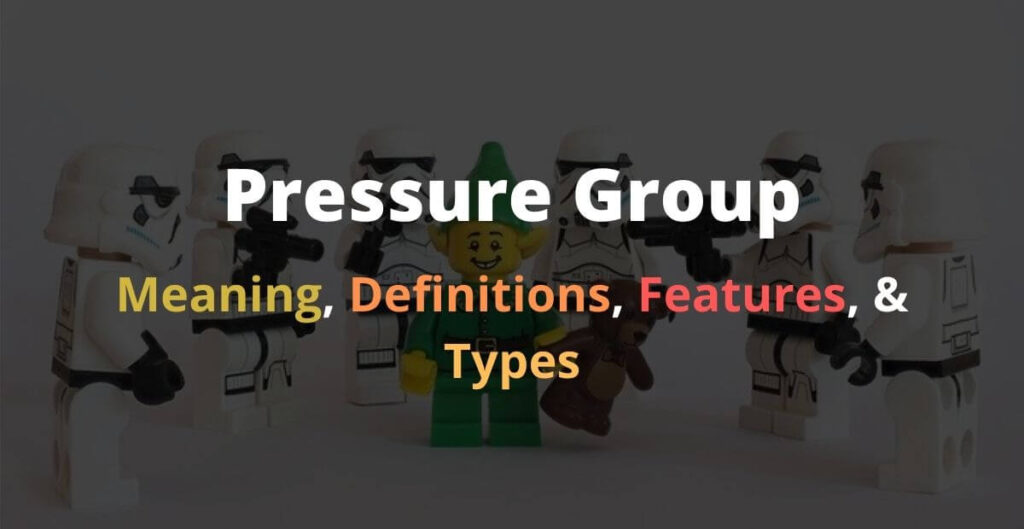In liberal democratic systems, there are two modes of mass representation. One is political parties and the electoral process, the other is the pressure groups. A pressure group is an association of people who have common interests and try to achieve their interests by influencing the government.
Actually, the concept of pressure groups originated in the USA. The pressure group has come from group theory. David Truman, Arthur Bentley, etc, is the pioneer of the group theory. Before understanding Pressure groups, it is very necessary to know about Group Theory.
Group Theory
Peoples make society and in every society, there are many groups, and people interact with each other through those groups. According to the group theorist, the government is distinguished from other groups in terms of its process and political characters.
Arthur Bentley in his book The Process of Government (1908), said that “a group means a certain portion of the men of society, taken, however, not as a physical mass cut off from other masses of men, but as a mass activity, which does not preclude the men who participate in it from participating likewise in many other group activities”.
According to Truman, a group is a collection of individuals who “on the basis of one or more shared attitudes, makes certain claims upon other groups in the society for the establishment, maintenance, or enhancement of forms of behavior that are implied in the shared attitudes, the shared attitudes constitute the interest”.
So it can be said that a group is basically constituted of a group of individuals who have shared interests. To fulfill their interest, they organized as a group and set their objectives to achieve those interests.
Read More: Political Theory And Why Should We Study Political Theory?
Meaning of Pressure Group
When we add pressure before groups, it means that groups are made to create pressure on some organizations or a particular group of people or government.
A group of people who have a similar kind of interest organized themselves and pressurize the government to the point of gaining recognition, legitimization, and realization of their specific interest.
These groups are created by focusing on various social, political, economic, religious, vocational, and other interests of the people.
The capture of government power, like the political party, is not aimed at the pressure groups. But the group exerts a powerful influence on determining government policy. By influencing or suppressing groups, interest groups seek to adapt government decisions to their own interests.
In modern society, there are many groups or organizations that influence government activities or decisions in particular. These groups, with special interests, directly or indirectly influence the political flow of the country.
Must Read- 3 Most Important Types of Political Theory
Definitions of Pressure Group
There are many definitions given by a lot of scholars. Here I have highlighted some definitions given by the most prominent scholar on pressure groups.
A pressure group has been defined as “an organized aggregate which seeks to influence the context of governmental decisions without attempting to place its members in formal governmental capacities”.
According to Alan R. Ball “… Pressure groups are firmly part of the political process and that they attempt to reinforce or change the direction of government policy, but do not wish, as pressure groups, to become the government.”
Henry Turner says that “by definition, pressure groups are non-partisan organizations which attempt to influence some phase of public policy. They do not themselves draft party programs or nominated candidates for public office…”
Features of Pressure Groups
In the socialist political system, the existence of Pressure groups is unnecessary. Such a political system has the necessary measures to protect the interests of all sections of society. The characteristics and functions of the pressure groups refer to the functions and characteristics of the pressure- groups in the liberal democratic system.
The following are particularly significant in the many functions and features of the Pressure groups-
- It plays a vital role in establishing public relations with the government. Through all these groups, the people’s scarcity and grievances, and demands are brought to the notice of the government. In this regard, the government is eager to resolve those shortcomings and meet the demands.
- It keeps a close watch on the activities of the government. Any disruption to the government’s decisions and actions comes to the attention of the groups, and the campaign is widely publicized. The countrymen get the opportunity to be fully informed about the error of the government.
- Pressure groups seek to gain widespread public support in favor of group interests and influence the government. For this purpose, groups collect information and news on various topics of their own interest.
- Pressure groups play a vital role in political socialization. Presently, each pressure group is governed and controlled by the sponsorship of any one political party. Opportunities and possibilities are created to transmit certain types of political values to the masses.
- Articulation and integration of different interests are other features of pressure groups. It represents the interests of different parts of society. The interests of the people belonging to different livelihoods are expressed through these groups.
- Pressure groups are always careful about government decisions, policies, and laws. This is because the main goal of all these groups is to influence the government as much as possible to bring government decisions and laws in favor of the group.
Through pressure groups, the authorities of the governing department and the law department can discern the nature of public opinion on a particular issue and are governed accordingly. Thus, the democratic appearance of the government remains characteristic.
Types of Pressure Groups
Pressure groups can be varied, such as student associations, educational institutions, labor unions, etc. Almond and Powell have discussed in detail the classification of pressure groups in the book Comparative Politics. These two modern state scientists have divided interest groups into four classes. These are mentioned below-
- Associational Groups
- Non-Associational Groups
- Institutional Groups
- Anomic Groups
1. Associational Groups
Associational pressure groups are expert group to present their self-interest claims. These are formally organized in the form of registered bodies having their own constitution or rules, finances, records, addresses of the office bearers, and others like this. Such groups are formed for the articulation of interest.
2. Non-Associational Groups
Non-Associational groups that are racial, ethnic, class, linguistic, etc. are seen. Dignity and class-based groups are also part of the non-associational pressure group. Not all of these groups are properly organized.
3. Institutional Groups
This group is made up of people from any profession. Such a group may be intended for the interests of its own members or any other group. These institutional forces play a significant role in the political system of the country. Such groups are seen in the legislatures, political parties, bureaucracy, and so on.
4. Anomic Groups
Such pressure groups usually originate from a particular event. Pressure groups of this kind naturally express their dissatisfaction with their smoky accusations and this group creates pressure on the country’s political system through protests, riots, assassinations, etc.
Must Read- Reasons For The Decline Of Political Theory [4 Important Factors ]
Techniques of Pressure Groups
Pressure groups usually use several techniques which they believe will serve their purpose effectively. Here I have mentioned four techniques that are used by the pressure groups mostly.
- Lobbying
- Strike
- Bandh
- Gherao
1. Lobbying
Lobbying is widely used by pressure groups in the USA. The effective influence of Pressure Groups on the US Congress is well known. Due to the lax organizational structure and lack of discipline in the US party system, these groups have the opportunity to influence members of Congress.
Pressure groups, through influential members of various committees of the US Congress, took initiatives to protect interests. To this end, several groups appointed their representatives in Washington.
All of these delegates influence the enactment of special laws in favor of group interests by communicating with active members of congressional committees on behalf of their respective groups.
The way in which groups seek to gain access to government decision-makers and create opportunities for their own discourse is called lobbying.
2. Strike
The strike is a common tactic of pressure groups. In very simple, a strike refers to the stoppage of work. This is a temporary stoppage of work for a specific reason and work will not resume until the settlement of the grievances is affected.
We frequently see in the newspapers that many trade union groups are doing strike their work to fulfilling their demands. Demands may be an increase in remuneration, reduce the duration of work, and others. In many cases, they are successful to fulfill their demands. It is only possible because of pressure groups.
3. Bandh
Bandh is an Indian tactic for pressurizing the government. It refers to the total strike of all offices, shops, markets, transport, and like this.
It is a devastating technique for organized violence to fulfill any political purpose of formation of the government, weakening or strengthening an alliance, humiliating and harassing public leaders in power or in opposition, etc.
Basically, it is used by the Political party but in the backend, a huge amount of pressure groups’ support strengthens its power to achieve its interests.
The duration of a Bandh is normally from one day to seven days. A few days back on the date of the Bandh, the Bandh’s organizers shout at the top of their voices that it will remain a peaceful protest.
But in reality, we see many incidents during the bandh such as the cutting of telephone lines, sabotaging railway tracks, and setting fire to railways, government buses, bridges, factories, and other government machinery.
4. Gherao
Like Bandh, Gherao is another tactic that is mostly used in India. When employers and factory managers are encircled in their offices by the laborers or fellow workers and until fulfilling the demands of laborers of fellow workers, they are encircled, the action is called Gherao. It is also a physical blockade either by encircled or forcible occupation.
Conclusion
From the above discussion, we can say that pressure groups play a crucial role in the enhancement of the interests of a particular group or another group. We all are part of society and we involve at least one such group which helps to achieve our interest in broader aspects.
In other words, Pressure groups help to determine the issues that are not only appropriate for immediate decision-making, but need to be incorporated into political activities, and draw people’s attention to them.
Let me share with you what you have learned from Pressure Group: Meaning, Definitions, Features, & 4 Types

